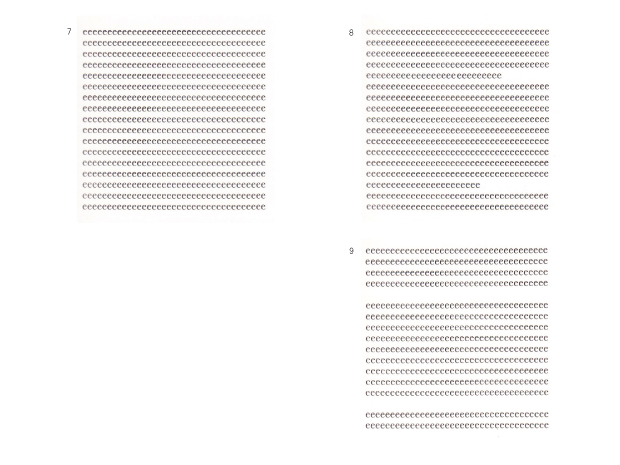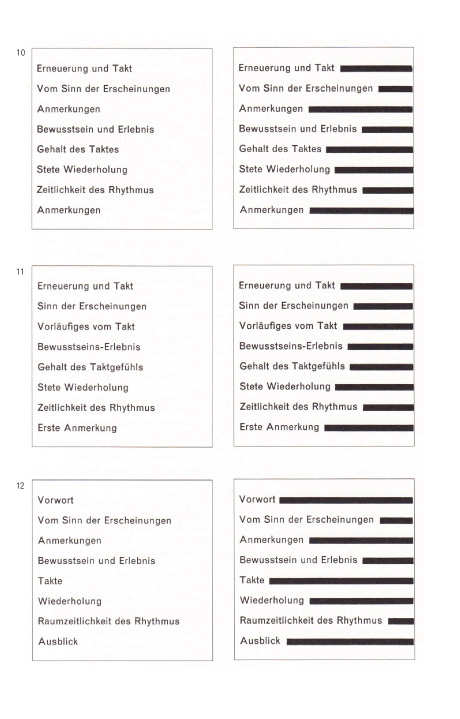 [/wide]
[/wide]
2.
Rhythmic values with a certain suggestion of influence
Our strictly schematic example of (7) shows setting with consistent line spacing. We are talking here about minimal rhythmic effect. Two breaks perform a rhythmic stimulation of
the previous example (8). This stimulation is the result of the two unequal line lengths and the white intrusions, but chiefly through the separation into three different values of grey. Only the designer who emulates a rigid scheme avoids breaks. It is best to treat rigid blocks of setting with mistrust; their shapes are too often the result of a hotchpotch of text conformity and enquiry. On the
other hand breaks are evidence of healthy and naturally unfolding typography. (9) shows a rhythmic approach to the setting through
the use of blank lines.
2.
ある程度意識されたリズム値
まったく図式的に構成された (7)の例は、均等な行間余白 を持ったレイアウ トを示している。ここには最小限のリズム的効果しか認めることができない。二つの行末のスペースが、このこわばった版面をリズミカルに活気づける (8)。この活性化はホワイトスペースの挿入と行長 の変化の結果である以上に、3つの異なるグレー価への分割によって達成されている。 厳格な規範に固執する デザイナーは逸脱をためらうが、四角四面な組版のかたまり にはまず不信感を持って接するのが一番良い。そのような形はほとんどの場合、テキストへの配慮や探求をこじらせた結果なのだ。その一方で、スペースが生まれているのは健康的で、自然に発展したタイポグラフィの証しなのだ。(9) は、空白行によるレイアウトのリズム化を示している。
During the previous centuries of printing the appearance of lines, that is the sequence of shorter or longer lines, was a hotbed of all imaginable tendencies. Today we are willing to accept these measures as a natural
course of the text with the least possible formal intervention. The alternation of short and long lines is a rhythmic flow and in order to demonstrate this flow clearly we shall
show the white opposing movement of the lines in black.
In (10) a normal arrangement of
lines with a normal flow is shown. (11) shows small differences in the line lengths, leading to a rhythmically weaker image. (12) shows a more severe arrangement of the lines. The large differences noted in the lengths bring about severe rhythmic movement, so severe in fact as to damage readability.
Helmut Schmid has wonderfully restructured the article in the idea 354 based on the article to be published in the April 1959 issue of “Typografische Monatsblatter” by Emil Ruder. So, we highly recommended that to be read the idea 354 thoroughly. And then you can get a deep understanding of this article.
過去数世紀の印刷において行の配列 (Zeilenfall)、つまり長短の行の並びは、考えられるかぎりのありとあらゆる傾向を示した。今日では我々は行の長さを、読む上で形式的な干渉のないテキストの自然な流れを基準として捉えようとしている。行の長短の変化は、リズミカルな流れを形づくるが、このリズムをはつきりとさせるために行の余白の部分を黒色で示してみたい。
(10) では普通のリズムを持った普通の行配列が示されている。 (11) ではそれぞれの行の長さに小さな変化が見られ、それに従って、リズム感に乏しいレイアウトになっている。 (12) は強烈な行レイアウトを見せている。激しい行の長さの変化は、読みやすさを圧倒してしまうほどに強烈なリズム運動をもたらしている。
このコンテンツはTypografische Monatsblatterの1959 4月号に掲載されたEmil Ruder氏の寄稿記事をHelmut Schmid氏が40年以上の歳月を要し、idea 354の中で編集、デザイン、紹介されたものを一部引用したものです。
次のことをお勧めします、もしあなたがidea 354を熟読すると、このコンテンツを表面的なレベルより深く理解することができます。
